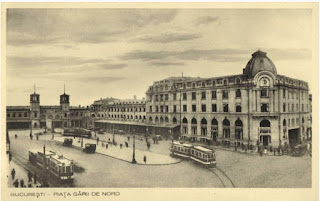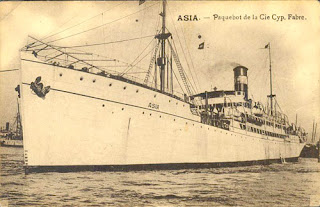 |
| Advertisement for the Fabre Line ships S.S. Bagra and S.S. Asia. Passage from Constantinople, Constanța, and Odessa to New York (top) and to Jaffa and Haifa (bottom). Abram Broitman took the S.S. Asia on a chartered voyage in July of 1924 with a group of 380 refugees. Image courtesy of the Alex Dworkin Canadian Jewish Archives |
Sometime between 1919 and 1923 the Broitmans had spent a few years in Kishinev with their Bershadsky cousins, with whom they had made the dangerous journey. But Kishinev had gotten crowded as an estimated 50,000 fellow Jewish refugees had flooded the Romanian border region abutting the newly-formed Soviet Union. Bucharest, further from the border, was better, but only slightly: Romanian authorities severely limited what employment their new Russian Jewish “guests” could seek. According to the Jewish Colonization Association, in 1924 there were still an estimated 4,000-8,000 Jewish refugees in Romania.2 Many, like the Broitmans, had visas allowing them to join family in the United States; but the passage of the restrictive and infamously discriminatory Johnson-Reed Immigration Act of 1924 effectively ended the Eastern European Jewish immigration wave of 1892-1914. So the Broitmans remained in Bucharest, supported in large part by the Jewish aid groups Central Relief and the Joint Distribution Committee (JDC).
Luckily, in 1924, the Jewish Colonization Association (JCA or ICA) in Canada was able to convince the Canadian government in Ottawa to accept a limited number of refugees. There were strings attached, of course.
- The refugees needed to demonstrate that they had sufficient financial resources that they wouldn’t be a burden on the state. Otherwise, the Jewish philanthropic organizations facilitating refugee resettlement had to raise funds to support them.
- A portion of the refugees needed to settle in the prairie provinces and work as farmers.
- The steamships used to transport the refugees needed to be Canadian-flagged vessels.
This was Abram Broitman’s chance. He would go to Canada, raise enough money to bring his wife (now pregnant) and children to join him, and eventually gain entry to the U.S. On June 24, 1924, Abram was issued a passport by the Russian Consulate in Bucharest indicating that he held Russian citizenship. This was remarkable, because the country of Russia had ceased to exist years earlier! But the Imperial Russian consulates remained in operation in large part to support the stateless refugees and manage Russian property abroad.3
| Passenger Record of Abram Broitman on the S.S. Asia, 1924. |
Abram wasted no time in arranging his departure. Ten days later, on July 4, 1924, he purchased a ticket (with funds supplied by American and Canadian donors through the JDC to the JCA) from Constanța, Romania to Halifax, Nova Scotia, Canada. Although he was a married lumber merchant, he indicated on his passenger record that he was a unmarried farmer – presumably to convince the Central Relief Committee officials to allow him passage. Over the next five days he made his way by train from Bucharest to the Black Sea port of Constanța, leaving his family behind.
Exactly 100 years ago this week, on July 9, 1924, Abram set sail on the S.S. Asia, a French-flagged vessel, with 380 fellow refugees. Destination: Canada.
Next time: Abram's Journey on the S.S. Asia
 |
| Postcard depicting Bucharest's North Station, circa 1930. |
 |
| Postcard depicting the Port of Constanța, 1927. |
 |
Postcard of Fabre Line S.S. Asia. The vessel met a tragic end in 1930 when it sank off the coast of Jeddah, Saudi Arabia. |
  |
Memo for Mr. Lyon Cohen regarding the number of refugees who may be sent to Canada Alex Dworkin Canadian Jewish Archives ICA. 6 January 1924. |
- For an account of a similar journey by fellow Savraner refugees, I recommend “Oh Say Can You See Chaos and a Dream of Peace” by Abraham Gootnick. University Press of America, 1987.
- Memorandum for Mr. Lyon Cohen, chairman of the Jewish Colonization Association of Canada regarding the number of Russian refugees who may be sent to Canada. Sent 6 Jan 1924. Alex Dworkin Canadian Jewish Archives. Montreal, Canada. ICA-S-CB-18. Two pages.
- Personal correspondence, Jeffrey Veidlinger, Joseph Brodsky Collegiate Professor of History and Judaic Studies, University of Michigan. 3 April 2023.


No comments:
Post a Comment